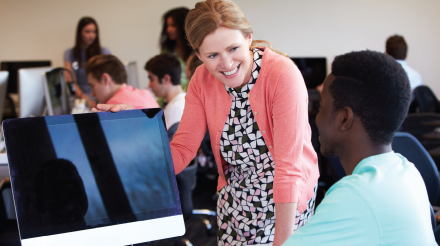Advances in technology and increased global competition are changing the workplace. But making sure our schools and our students are ready for the future of work is no easy job.
America’s business leaders are worried. Trustees from the nation’s institutions of higher education are worried. American workers are worried. There is a whole lot of worrying going on when it comes to America’s ability to remain intellectually and economically competitive in an increasingly unpredictable global market. While these concerns are not new — A Nation at Risk sounded the alarm in 1983 that America was in danger of falling behind other nations — they feel far more urgent now, in light of advances in digital technology and the growth of the global economy. The “risks” to which the report’s title alludes seem more tangible now that we’ve been introduced to Siri and Alexa, and now that a whole bunch of kids in Shanghai and Helsinki are outcompeting us on international assessments.
In the face of these concerns, researchers, policy makers and pundits do what our kind do best: We write and talk endlessly about them. The result is a cluster of new reports that focus on the future of work and the inextricable link between education and workforce readiness. All reveal a certain amount of fear for the future, and since it is unusual for business leaders, educators, and workers to all be on the same page about anything, each deserves a closer look.
The higher ed perspective
A 2020 report from the Association of Governing Boards of Universities and Colleges (AGB) and Gallup shows that only a minority of higher education trustees agree that U.S. college graduates “have the skills they need to be competitive in the global economy.” Only 35% of respondents to the AGB 2020 Trustee Index expressed confidence in U.S. graduates (a significant drop since 2017), and only 26% of trustees agreed that colleges and universities understand what employers are looking for in job candidates.
Other membership organizations that represent university trustees and alumni have also expressed concerns that their institutions are not in sync with what their students need to be successful in the workplace. The AGB report points out that these findings are particularly significant because most university and college trustees come from the business sector. In other words, most of them know of what they speak because they are hiring and firing people every day and likely have firsthand experience with recent graduates.
In addition, trustees are trying to manage an increasingly complex education-to-workforce pipeline at a time when the entire sector seems financially unstable. A whopping 85% of trustees expressed serious concerns about the skyrocketing costs of higher education for both students and institutional leaders. These financial challenges may help explain why so many universities and colleges have been reluctant to make the kind of changes needed to prepare a new and different kind of workforce.
The future of business
Microsoft Education and McKinsey & Company (2020) also issued a report focused on what the class of 2030 will need to know to “thrive in work and in life.” This report is focused on K-12 education, and while many of the solutions are focused on technology (the report is, after all, from Microsoft), let’s put that bit of self-promotion aside to consider their conclusions. The report states that by 2030 occupations requiring lower levels of education will lose more than 11 million jobs. At the same time, the fastest-growing occupations will require a higher level of knowledge and a more sophisticated set of skills. This kind of gap — in which those on the lower end of the value scale lose even more ground while those on the higher end gain ground — has become all too familiar. This year’s National Assessment for Education Progress results revealed a similar divergence, with low performers dropping even lower and high achievers flying higher (Ferguson, 2020). One might argue that this “winners take all” pattern is something Americans are becoming a little too accustomed to.
The report also stresses a need for “greater student-centricity,” which I believe is just a fancy way of saying more personalized learning opportunities. Naturally, the good people at Microsoft believe technology is the answer to more personalization, and, in all fairness, they are largely correct. Technology offers both educators and students more opportunities to gain the knowledge and skills they will need to succeed in those fast-growing and high-achieving occupations. But the report also talks about the growing value employers place on social and emotional skills. In almost every field, workers today need to think and work collaboratively and manage themselves amid constantly changing circumstances. But it will take more than technology to teach these skills.
The voices of workers
Despite the cacophony of individuals and organizations talking about workforce readiness, the voices of American workers remain largely absent from the conversation. We know many workers are already feeling the effects of automation, and the prospect of an increased reliance on artificial intelligence (AI) is looming on the horizon, but do we really understand how these and other workplace changes affect the daily lives of current and future workers? To better understand and put a human face on the “future of work” rhetoric, Molly Kinder, the David M. Rubenstein Fellow at the Brookings Institution in Washington, is focusing her research on traditionally overlooked and unheard segments of the American workforce, such as women, Black people, and Latinx people. Kinder points out that by excluding workers from conversations and decisions about new technologies and other changing workforce needs, we lose out on their valuable insights that could ultimately support worker readiness.
In a 2019 report, Worker Voices: Technology and the Future for Workers, Kinder and colleague Amanda Lenhart share what they have learned from workers so far. Perhaps most important is how difficult it is to prepare for the changes already happening in present-day work environments and those expected in the near future. The authors point out that “Low pay and economic insecurity sharply limit workers’ ability to prepare for — and access — a better future of work.” Workers also struggle to acquire the kinds of skills, degrees, and training they need and desire. For many, the high cost of college and a range of other obstacles and setbacks can prevent or sideline educational pursuits. They are eager for “learning opportunities suited to their time and resource constraints, including on-the-job training, employer-provided skill development, professional credentials, short courses, and apprenticeships.”
Common themes
When taken all together, these reports all seem to point to some common themes. First, automation and AI have been and will continue to transform all aspects of work. While some examples of that transformation are already apparent, others have yet to be realized. These changes will affect both public- and private-sector jobs as well as most aspects of our daily lives. Since no one really knows what impact all of this innovation will have on the American worker, it can be difficult to prepare for what may come. These uncertainties will continue to challenge education and industry leaders as they plan for the future of work.
Second, most workers will face new circumstances as the modern workplace continues to evolve. As unorthodox workspaces, new technologies, and colleagues who work remotely (or may not even be human) become more common, workers will require new and different levels of social and emotional acumen. Social and emotional skills, once dismissed as mere “soft skills,” are now highly prized in the workplace and will almost certainly continue to be important. Despite all the technology and automation, the future of work will still depend on those of us who have broad and deep skills, can manage change, communicate effectively, and play well with others.
Finally, it is almost impossible to underestimate how important education is to a nation’s long-term stability and prosperity. From early childhood and throughout an individual’s working life, education is the gift that keeps giving. No single investment contributes more to our nation’s economic, political, and social well-being. Unfortunately, our K-12 and postsecondary education systems are showing signs of instability and underperformance at a time when the global economy is demanding higher levels of education and training. When we see growing achievement gaps and more than a trillion dollars in student loan debt, there is a good reason for all of us to be a little worried.
References
Association of Governing Boards & Gallup. (2020). The AGB 2020 trustee index: Concern deepens for the future of higher education. Washington, DC: Authors.
Ferguson, M. (2020). What the NAEP reveals. Phi Delta Kappan, 101 (5), 62-63.
Kinder, M. & Lenhart, A. (2019). Worker voices: Technology and the future for workers. Washington, DC: New America.
Microsoft Education & McKinsey & Company. (2020). The class of 2030 and life-ready learning: The technology imperative. Redmond, WA: Microsoft.
ABOUT THE AUTHOR

Maria Ferguson
Maria Ferguson is an education policy researcher, thought leader, and consultant based in Washington, DC.










